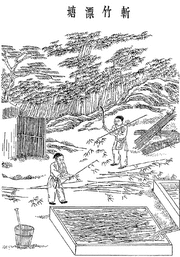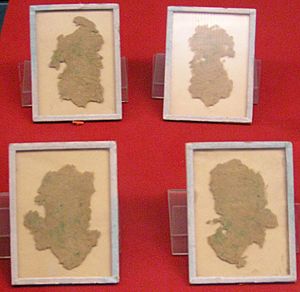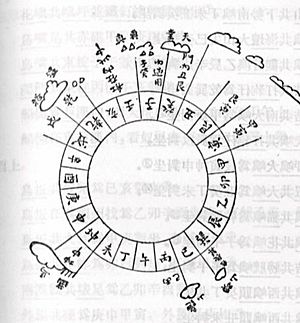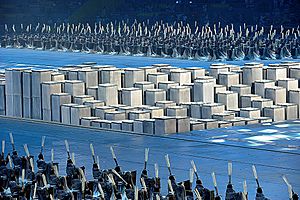Four Great Inventions facts for kids
Quick facts for kids Four Great Inventions |
|||||||||||||||
|---|---|---|---|---|---|---|---|---|---|---|---|---|---|---|---|

Five major steps in papermaking, outlined by Cai Lun in AD 105
|
|||||||||||||||
| Traditional Chinese | 四大發明 | ||||||||||||||
| Simplified Chinese | 四大发明 | ||||||||||||||
| Literal meaning | four great inventions | ||||||||||||||
|
|||||||||||||||
The Four Great Inventions are amazing discoveries from ancient China. They are celebrated in Chinese culture because they show how advanced China was in science and technology long ago. These four inventions are the compass, gunpowder, papermaking, and printing.
These inventions changed the world in huge ways. They helped civilizations everywhere grow and develop. Some modern Chinese experts even say that other Chinese inventions were also very important. But the Four Great Inventions really highlight how technology was shared between the East and West.
Contents
Why Are These Inventions So Important?
The idea of "The Three Great Inventions" was first suggested by a British thinker named Francis Bacon. Later, other scholars like Walter Henry Medhurst agreed. They believed that printing, gunpowder, and the compass were brought to Europe by Arab traders. This happened during a time of big changes in Europe, called the Renaissance.
Bacon, who was an important advisor to King James I of England, wrote about how these discoveries changed everything. He said they changed literature (books), warfare (fighting), and navigation (traveling by sea). He felt these three inventions had a bigger impact on human life than even empires or stars.
Another famous thinker, Karl Marx, also wrote about these three inventions. He said they helped bring about a new kind of society. Gunpowder changed battles, the compass opened up world trade, and printing helped spread new ideas.
A British expert on China, Medhurst, also pointed out China's amazing inventions. He said the Chinese compass, printing, and gunpowder greatly helped European civilization grow. Later, a missionary named Joseph Edkins added papermaking to the list. He noted that Japan did not have such inventions as paper, printing, the compass, and gunpowder.
Papermaking: A Revolution in Writing
Papermaking is thought to have started in China around AD 105. An official named Cai Lun, who worked for the emperor during the Han dynasty (202 BC – AD 220), is credited with creating paper. He used materials like mulberry bark, other plant fibers, old rags, fishing nets, and hemp waste.
Paper was used for wrapping and padding in China since the 2nd century BC. But it only became widely used for writing around the 3rd century AD. Recently, archaeologists found paper with Chinese characters on it from as early as 8 BC!
Before paper, ancient Chinese people wrote on many different things. They carved words on pottery, animal bones, and stones. They also wrote on bamboo or wooden strips, and on silk fabric. However, these materials were either too heavy or too expensive for everyone to use. The invention of paper completely changed how people wrote and shared information.
By the 6th century in China, paper was even used for toilet paper. During the Tang dynasty (618–907), people folded and sewed paper into square bags to keep tea fresh. The Song dynasty (960–1279) was the first government to print and use paper money.
The Compass: Finding Your Way
A compass is a tool that helps you find directions. It is very important for navigation, exploring new places, and many other activities. In ancient times, the compass had a huge impact on trade, wars, and sharing cultures.
Before the compass, people used the sun, moon, and stars to find their way. This was especially true when sailing on the open ocean. But if the weather was bad or cloudy, it was very hard to know where you were going.
The first ideas for the compass came from the Warring States period (476–221 BC). Back then, a special magnetic stone called a lodestone was used. It was called the "south-governor" (sīnán). The first mention of a magnetic device used for navigation was in a Chinese book from 1040–1044. It described an iron "south-pointing fish" floating in water. This fish would point south and was useful for finding direction at night. The first compass with a suspended magnetic needle was written about by Shen Kuo in 1088.
During the early Song dynasty, a round compass with a small magnetic steel needle was developed. One end of the needle pointed south, and the other pointed north. By the Northern Song dynasty (960–1127), the compass had spread to the Arab world and Europe.
The Chinese also used a "dry compass" during the Song and Yuan dynasties. This was a wooden frame shaped like a turtle, hung upside down. A lodestone was sealed inside, and a needle at the tail would always point north. Even after European compasses were adopted in China later, the Chinese dry compass was still used until the 18th century.
The invention of the compass made it much easier to sail across vast oceans and explore new lands. It even helped lead to the discovery of the New World.
Gunpowder: From Fireworks to Weapons

Gunpowder was first used in China to make fireworks for festivals and big events. Later, it became a powerful explosive for cannons, fire-arrows, and other military weapons. During the Song and Yuan dynasties (960–1368), there were many battles. This led to a high demand for gunpowder and its mass production.
Gunpowder was invented in the 9th century by Chinese alchemists. They were actually trying to find an elixir of immortality (a potion to live forever). By 1044, a Song dynasty book called Wujing Zongyao described different gunpowder formulas. These formulas had nitrate levels from 27% to 50%. By the late 12th century, Chinese gunpowder was strong enough to burst through cast iron containers. This led to the first hollow, gunpowder-filled grenade bombs.
In 1280, a large gunpowder storage building in Weiyang accidentally caught fire. The explosion was so massive that 100 guards were killed instantly. Wooden beams and pillars were blown high into the sky and landed miles away from the explosion site.
By the mid-14th century, the explosive power of gunpowder was greatly improved. A book called Huolongjing by Jiao Yu described many military uses for gunpowder. The nitrate levels in gunpowder formulas had risen to 12% to 91%. The Chinese also learned how to make explosive round shot by filling hollow shells with this stronger gunpowder. Evidence shows that a more powerful type of gunpowder, called corned gunpowder, was used in China by 1370.
Printing: Spreading Knowledge
Printing was invented in China during the Tang dynasty (AD 618–906). The first mention of printing is from AD 593. The Sui Emperor Wen-ti ordered the printing of Buddhist pictures and scriptures.
Woodblock Printing
The oldest type of Chinese printing used blocks made from wood. These blocks were used to print on textiles (fabrics) and to make copies of Buddhist scriptures. Short religious writings were also printed this way and carried as good luck charms.
The Chinese invention of woodblock printing happened before the first dated book, the Diamond Sutra, in 868. This created the world's first "print culture." A curator from the Metropolitan Museum of Art, A. Hyatt Mayor, said that the Chinese truly invented the way of communication that was most important until our modern age. Woodblock printing worked better for Chinese characters than movable type. Even though the Chinese also invented movable type, it did not replace woodblock printing. Western printing presses were introduced in the 16th century but were not widely used in China until the 19th century.
Woodblock printing for textiles was used centuries before text printing in all cultures. It was first found in China around 220 AD. It reached Europe by the 14th century and was used for art prints and playing cards.
Movable Type Printing
Printing in Northern China became even more advanced by the 11th century. The Song dynasty scientist Shen Kuo wrote that an artisan named Bi Sheng (990–1051) invented ceramic movable type printing. Later, people like Wang Zhen (around 1290–1333) invented wooden movable type. This later influenced the development of metal movable type printing in Korea (1372–1377).
Movable type printing was a lot of work if you only needed to print a few books. You had to arrange thousands of individual characters. But if you were printing thousands of books, it was very efficient and fast. Many cities in China used movable type printing, both wooden and metal. Wealthy families and large businesses adopted it. The Qing dynasty court even sponsored huge printing projects using woodblock movable type in the 18th century. Even though Western printing techniques became more common, woodblock movable type printing is still used in some parts of China today.
Cultural Influence
The Four Great Inventions are a big part of Chinese schooling. They are a source of great pride for the Chinese people.
In 2005, the Hong Kong postal service made special stamps featuring the Four Great Inventions. These stamps were first released on August 18, 2005.
The Four Great Inventions were also a main theme at the opening ceremony of the 2008 Beijing Summer Olympics. Papermaking was shown with a dance and an ink drawing on a huge piece of paper. Printing was represented by dancing printing blocks. A copy of an ancient compass was displayed. And gunpowder was shown through the amazing firework displays during the ceremony. A survey found that Beijing residents thought the part about the Four Great Inventions was the most touching part of the opening ceremony.
See also
 In Spanish: Cuatro Grandes Inventos para niños
In Spanish: Cuatro Grandes Inventos para niños





